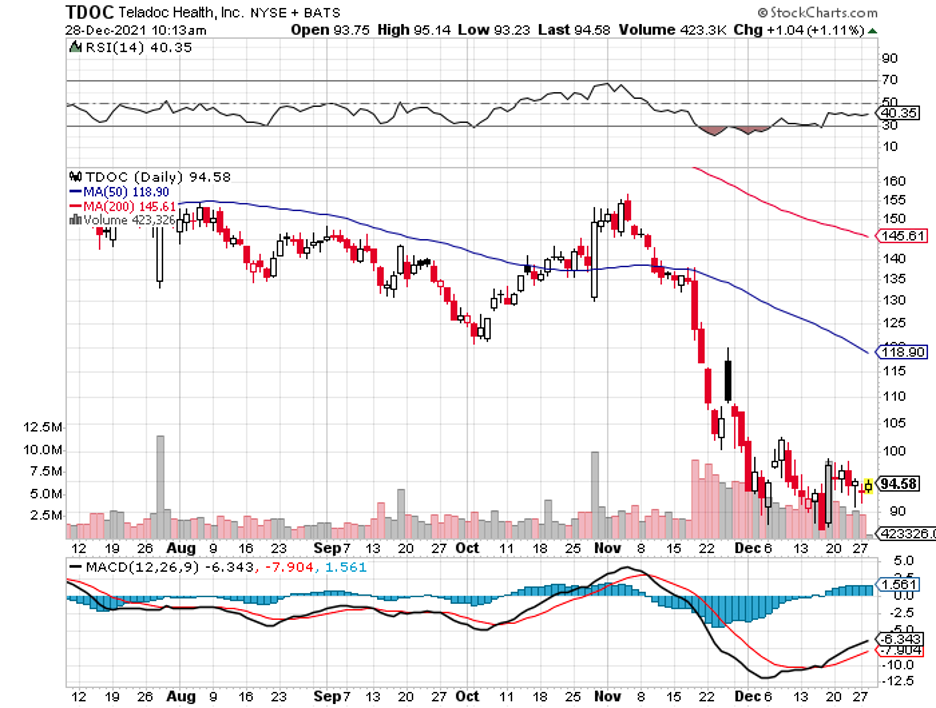Alongside the likes of Pfizer (PFE), BioNTech (BNTX), and Moderna (MRNA), another name stood out during the pandemic: Teladoc (TDOC).
This telehealth company was one of the biggest breakout stars amid the worst periods of the COVID-19 pandemic, with its shares skyrocketing 138%—a feat sustained throughout 2020.
However, Teladoc’s narrative faltered in 2021.
The change wasn’t in terms of the company’s financial future. If anything, the company had been consistent in recording increasing revenues and visits. Teladoc actually even boosted its earnings guidance this year.
Despite all these, the stock fell by roughly 50%.
Looking at the reasons for this baffling fall, it became evident that investors started to fret over the gradual reopening of the economy and the return of people to offices.
They believed that these would result in patients abandoning virtual health consultations and opting to go back to their doctor’s clinics.
As far as we can see, though, that has not happened yet.
Moreover, the recent events and predictions about the future all but guarantee that these fears are baseless. Now, this raises the question of whether or not Teladoc is set to rebound in 2022.
It’s sort of obvious that the company has been moving alongside the COVID-19 headlines, but this doesn’t necessarily mean that Teladoc’s long-term plans depend heavily on the pandemic.
The vital thing we need to understand is that telehealth is here to stay. The pandemic merely accelerated the adoption of this groundbreaking technology.
There’s actually a widespread misunderstanding of Teladoc’s goal over the long term. Some investors seem to assume that the company aims to replace physical healthcare services.
This is extremely far from the truth.
What Teladoc wants to do is simply provide a complementary platform for the physical system.
That is, the company aims to virtualize all the things that can be virtualized and serve as the front door to the actual physical care.
Doing so will offer a more convenient option for patients and for the entire healthcare industry because this new and improved system can generate savings and better allocate resources in one of the most woefully managed and inefficient sectors across the globe.
Our current traditional healthcare system is extremely fragmented. Patients visit an average of 19 doctors in their lifetime, and every new doctor typically necessitates a new practice, a new professional relationship, and another set of medical records.
To get rid of the stress, prevent “wasting time” in waiting rooms, and sometimes receive unsatisfying experiences, which can even lead to unresolved or undetected health issues, Teladoc has come up with a comprehensive system.
It built Primary360, which it dubbed as the “whole-person care” platform.
The idea behind “whole-person care” is to bring all the services, including mental health, primary healthcare, and even treatments for chronic conditions, in one virtual package. This can then be easily accessed via the patient’s phone.
Teladoc integrates data and analytics to develop personalized healthcare experiences for its users, which became even more accurate and comprehensive thanks to its $18.5 billion acquisition of Livongo.
Another advantage in acquiring Livongo is its ability to work with AI.
Virtual care has the ability to offer more proactive solutions as opposed to reactive treatments.
Having a massive set of data, Teladoc can provide proactive measures to manage or prevent symptoms instead of mitigating them when they manifest.
After all, what would patients want more?
Their doctors informing them that they have a high risk of a heart attack in the following month if they fail to receive treatment or wait until it actually happens?
Wearables, such as smartwatches and Oura rings, can send data to Teladoc, which can then be used to prevent these kinds of health crises from arising.
Aside from Livongo, Teladoc has also acquired BetterHelp in 2015 for $4.5 million to form part of its “whole-person care” platform.
This acquisition, which has been on track to rake in $100 million in revenue in 2021, is geared towards mental health services.
Teladoc’s earnings reports in 2021 have been reassuring. In the third quarter, for instance, the company’s revenue skyrocketed 81% while patient visits rose 37% to reach over 3.9 million.
Meanwhile, the company estimates the “whole-person care” to be worth roughly $75 billion within its current client base.
Moreover, the National Labor Alliance of Health Care Coalitions, the largest organization of labor groups, announced that it will make Teladoc’s complete set of services available to all its members.
For context, these members pay for the health services of over 6 million individuals.
Going back to the question of whether Teladoc shares will bounce back in 2022, I think it’s clear that it can easily recover given its current trajectory.
In 2020, the telehealth industry was valued at $62.45 billion. By 2030, the telemedicine segment worldwide is projected to reach more than $431 billion.
Meanwhile, the compound annual growth rate (CAGR) from 2021 until 2030 is estimated to be at 26%.
Given Teladoc’s pioneering status, the company may even surpass the expectations from the industry. At a target 2022 revenue of $2.6 billion and $4 billion by 2024, the company’s projected CAGR is at 25% to 30% in the next three years.
Undeniably, Teladoc has fallen out of favor this year. However, the company is far from underperforming.
In fact, it has been doing an excellent job at sticking to its long-term objectives.
Looking at its low valuation at the moment, Teladoc holds the potential to become a highly rewarding venture for long-term investors who are capable of focusing on the fundamentals instead of the short-term noise.

